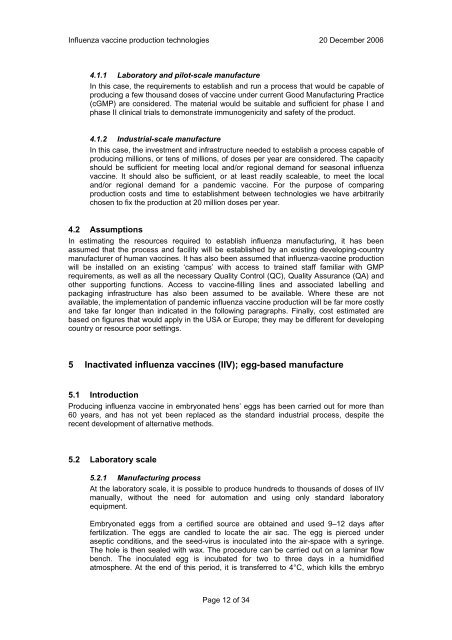A review of production technologies for ... - World Health Organization
A review of production technologies for ... - World Health Organization
A review of production technologies for ... - World Health Organization
You also want an ePaper? Increase the reach of your titles
YUMPU automatically turns print PDFs into web optimized ePapers that Google loves.
Influenza vaccine <strong>production</strong> <strong>technologies</strong> 20 December 2006<br />
4.1.1 Laboratory and pilot-scale manufacture<br />
In this case, the requirements to establish and run a process that would be capable <strong>of</strong><br />
producing a few thousand doses <strong>of</strong> vaccine under current Good Manufacturing Practice<br />
(cGMP) are considered. The material would be suitable and sufficient <strong>for</strong> phase I and<br />
phase II clinical trials to demonstrate immunogenicity and safety <strong>of</strong> the product.<br />
4.1.2 Industrial-scale manufacture<br />
In this case, the investment and infrastructure needed to establish a process capable <strong>of</strong><br />
producing millions, or tens <strong>of</strong> millions, <strong>of</strong> doses per year are considered. The capacity<br />
should be sufficient <strong>for</strong> meeting local and/or regional demand <strong>for</strong> seasonal influenza<br />
vaccine. It should also be sufficient, or at least readily scaleable, to meet the local<br />
and/or regional demand <strong>for</strong> a pandemic vaccine. For the purpose <strong>of</strong> comparing<br />
<strong>production</strong> costs and time to establishment between <strong>technologies</strong> we have arbitrarily<br />
chosen to fix the <strong>production</strong> at 20 million doses per year.<br />
4.2 Assumptions<br />
In estimating the resources required to establish influenza manufacturing, it has been<br />
assumed that the process and facility will be established by an existing developing-country<br />
manufacturer <strong>of</strong> human vaccines. It has also been assumed that influenza-vaccine <strong>production</strong><br />
will be installed on an existing ‘campus’ with access to trained staff familiar with GMP<br />
requirements, as well as all the necessary Quality Control (QC), Quality Assurance (QA) and<br />
other supporting functions. Access to vaccine-filling lines and associated labelling and<br />
packaging infrastructure has also been assumed to be available. Where these are not<br />
available, the implementation <strong>of</strong> pandemic influenza vaccine <strong>production</strong> will be far more costly<br />
and take far longer than indicated in the following paragraphs. Finally, cost estimated are<br />
based on figures that would apply in the USA or Europe; they may be different <strong>for</strong> developing<br />
country or resource poor settings.<br />
5 Inactivated influenza vaccines (IIV); egg-based manufacture<br />
5.1 Introduction<br />
Producing influenza vaccine in embryonated hens’ eggs has been carried out <strong>for</strong> more than<br />
60 years, and has not yet been replaced as the standard industrial process, despite the<br />
recent development <strong>of</strong> alternative methods.<br />
5.2 Laboratory scale<br />
5.2.1 Manufacturing process<br />
At the laboratory scale, it is possible to produce hundreds to thousands <strong>of</strong> doses <strong>of</strong> IIV<br />
manually, without the need <strong>for</strong> automation and using only standard laboratory<br />
equipment.<br />
Embryonated eggs from a certified source are obtained and used 9–12 days after<br />
fertilization. The eggs are candled to locate the air sac. The egg is pierced under<br />
aseptic conditions, and the seed-virus is inoculated into the air-space with a syringe.<br />
The hole is then sealed with wax. The procedure can be carried out on a laminar flow<br />
bench. The inoculated egg is incubated <strong>for</strong> two to three days in a humidified<br />
atmosphere. At the end <strong>of</strong> this period, it is transferred to 4°C, which kills the embryo<br />
Page 12 <strong>of</strong> 34

















